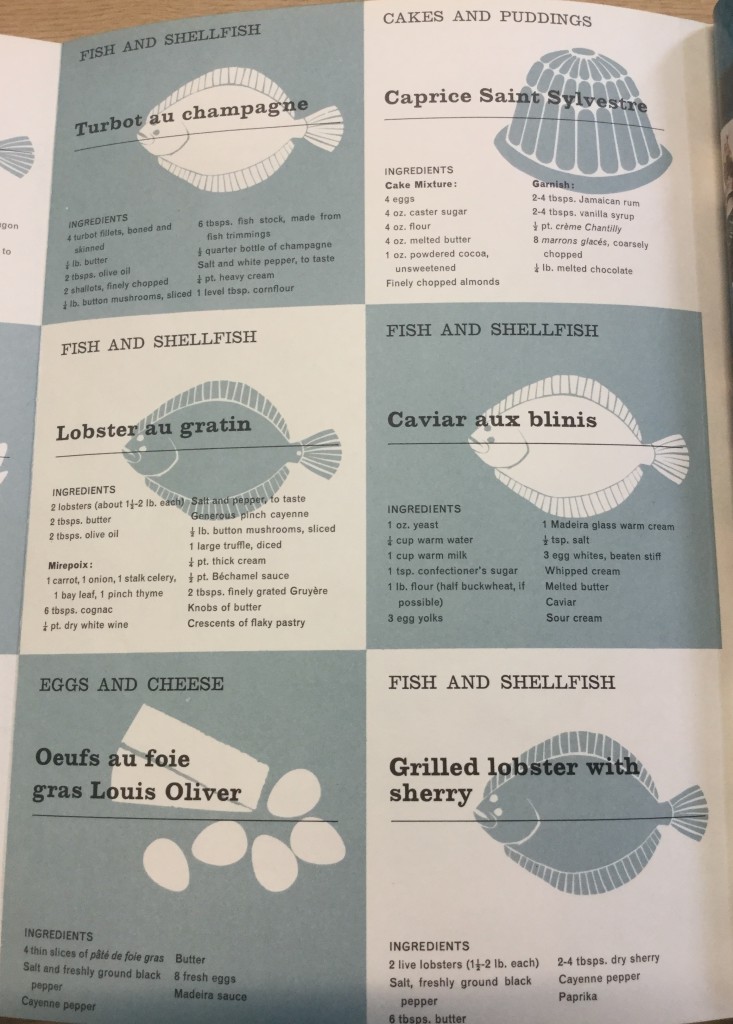VOGUE: Part 1 – more than a fashion magazine
To celebrate 100 years since British VOGUE was published we take a look at different aspects of the magazine from the 1950s to the present day. In this first piece we see how VOGUE has, until recently, always been more more than just a fashion magazine covering subjects such as travel, art, literature, food and drink, music and film alongside fashion and beauty.
FOOD
In the early 1950s VOGUE’s cookery column was written by a range of people including Harry Botsford (Cooking game – August 1953) and Madeline Miller (Crepes – September 1953).
In 1956 Elizabeth David began working for VOGUE. Her first article appeared in the May issue and over the next year she wrote a series of articles about seasonal food. In 1957 she followed this by writing about French regional cooking and in the June 1958 issue she began a series on Food in Italy, beginning with antipasti. This was soon followed, in 1959, by a series on cooking hazards . Her book French Provincial Cookery was published in 1960 and she used the research for this book to write a series on markets in France for VOGUE. David introduced ingredients such as olive oil that we now take for granted but which, in the 1950s, you were more likely to find on the shelves of your local chemist than in you local grocery store. David continued to write for Vogue until 1961.
At the end of 1961 Robert Carrier took over as food editor and the December issue saw the first article in his Creative Cookery series in which he discussed the use of garlic and fresh herbs. This issue also saw the first Robert Carrier’s cut-out recipes cards – these were printed on heavier paper and were designed so that they could be removed and kept in the specially designed container. Recipes included medallions of veal parmesan, eggs in aspic and Moroccan steamed lamb. These continued until 1964. How many of these still survive in kitchen drawers somewhere?
Arabella Boxer succeeded Carrier as food editor in January 1967 but left after two years because she had run out of ideas. However, she was persuaded to return and in May 1975 she joined Pamela Harlech as food editor and remained until 1991. Annie Bell followed next and Nigella Lawson joined at the end of 1995 with her first column being about ways to survive in the kitchen over Christmas. This was before she was a TV chef and her first book, How to Eat, wasn’t published until 1998. She wrote a column for VOGUE until March 2002 after which the food column ceased.
The post of food editor had become “food and travel editor” and then “living and travel editor” which later became the “living editor”, but this post disappeared along with the section. The VOGUE Living section of the magazine, which used to include food and restaurant reviews, articles on design and travel dwindled until there was just a part of the Regulars section called Living, but even that has now gone.
TRAVEL
Travel featured prominently in the magazine during the 1950s and 1960s and until the late 1980s there was often a separate travel section. At one time the only foreign travelling done was by those in the armed forces and had often been highly dangerous. After the Second World War, the long years of austerity encouraged in the public a hunger for new sights and experiences. Travelling abroad was still out of the reach of most people but, as ever, VOGUE was selling dreams. In May 1952 the Travel section included articles on Venice, Corsica and Brittany. The idea of travelling abroad by car gained increasing popularity with those who could afford to do so (this was before the days of cheap air travel and the Channel Tunnel) and a feature in July 1956 was entitled Across Europe by Car. This not only gave details of a couple of routes and itineraries – Ostend to Venice and Boulogne to Florence – but also described two ways to cross the Channel. A Ford Zephyr was flown in a plane from Southend Airport to Ostend, using the Channel Air Bridge Service, and a Sunbeam Rapier was taken by British Railways car ferry from Dover to Boulogne.
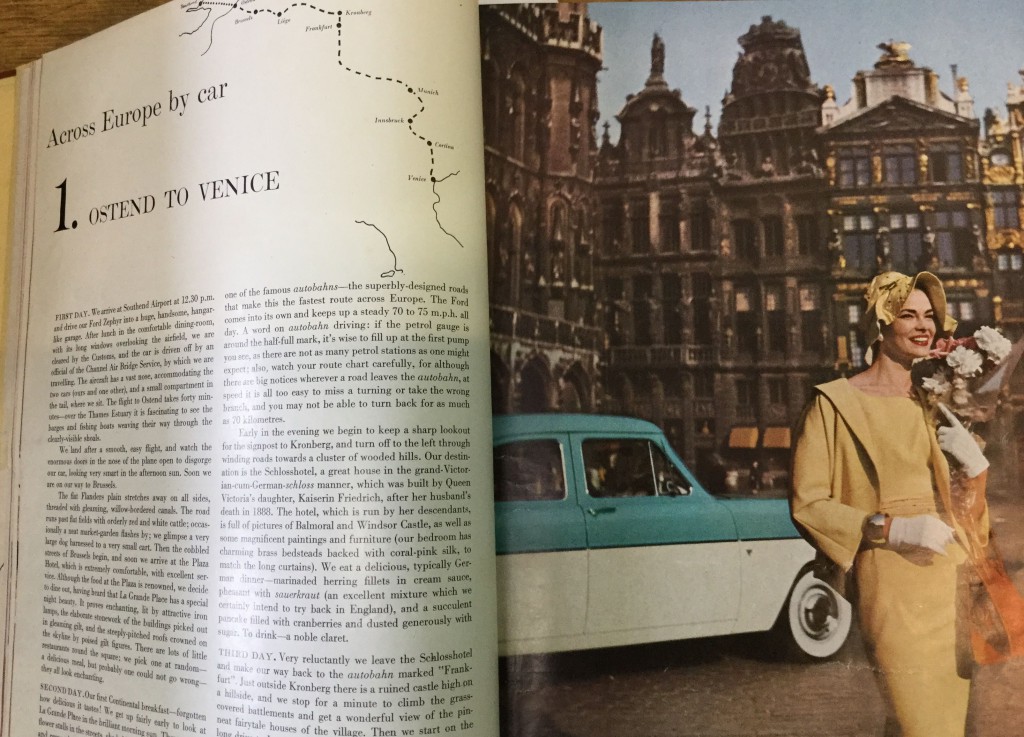
Travel features were often combined with a fashion shoot, as in the November 1956 issue when Penelope Gilliatt wrote about India, with accompanying photographs by Norman Parkinson of models wearing Jaeger, Dior, and Horrockses.
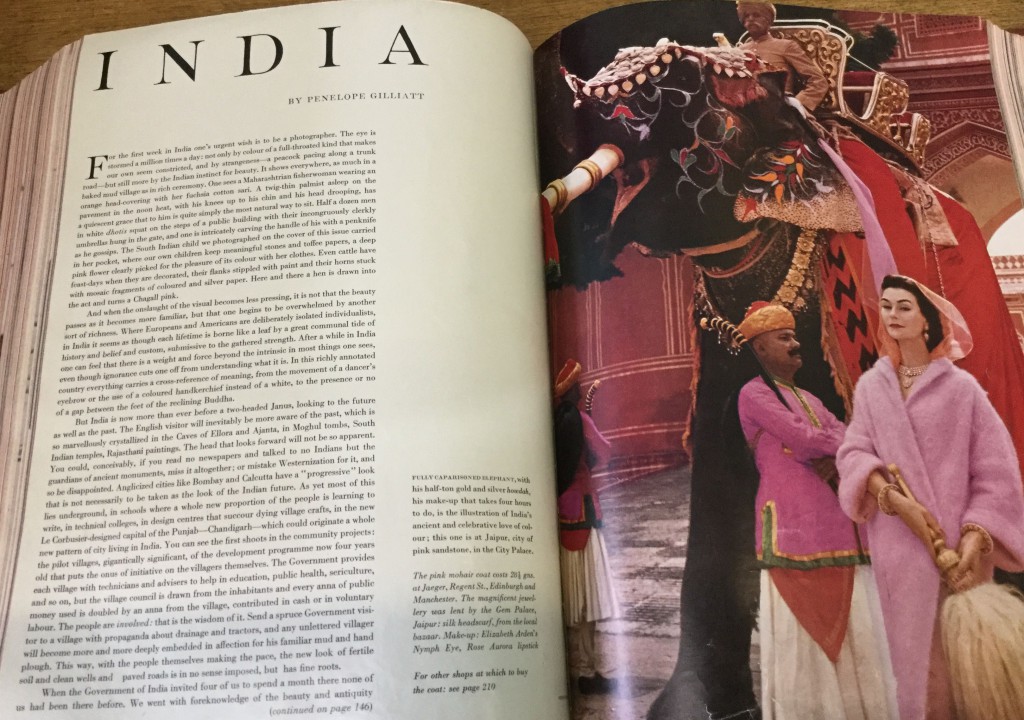
In the 1960s and 1970s foreign holidays slowly became affordable to ordinary people, while those with time and money on their hands travelled more widely, more exotically and more often.
In the 1990s travel articles appeared under the VOGUE Living section but by the 2009, the travel feature was often just a page called Fashion Travel, featuring a particular location that had been used for a fashion shoot in that issue, with details of where to eat, stay and how to get there.
CARS
Possibly rather surprisingly, for a magazine that was aimed primarily at women, cars featured regularly in the magazine during the 1950s and 1960s. The British car industry was trying to encourage the public to buy cars and women were increasingly part of the motoring public. As well as advertisements for cars there were also features and a regular motoring column.
In VOGUE of November 1956 there was a feature called The Car in Your Life which began with the opening sentence:
The latest lines in cars and clothes have quite a lot in common – example, dash and dignity.
The accompanying photographs showed human models alongside the latest car models, such as the Hillman Minx de Luxe, the Vauxhall Cresta, the Ford Zephyr and the Vanguard Estate.
Margaret Jennings , a rally and racing driver and motoring correspondent for VOGUE from 1948 to 1957, wrote a regular column called the Woman at the Wheel in which she featured women and their cars. So, in January 1956 we have Mrs Harold Carrington and her Bentley Continental and in April 1956 Miss Joyce Warner and her Triumph TR2. Nancy Mitchell took over the column in March 1957 and, as well as giving motoring advice such as how to choose your first car, she often reviewed cars. In July 1960 she wrote about the newly produced Morris Mini-Minor. Mitchell was also a successful rally drive and part of the BMC (British Motor Corporation) rally team. She won the European Ladies Rally Championships in 1956 and 1957.
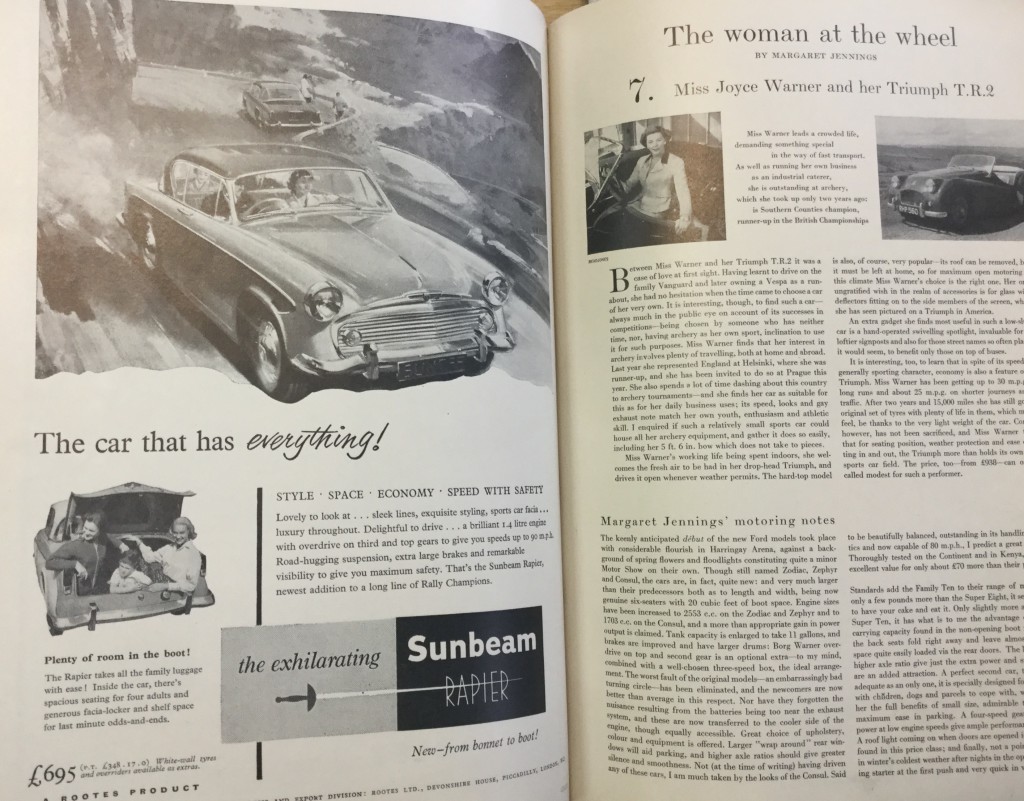
HOROSCOPES
Horoscopes first appeared in January 1972 and were written by Francesco Waldner who was succeeded by Wanda Starr (surely a pseudonym) in the 1990s and then Shelley Von Stunckel followed. Horoscopes ceased to appear in the magazine in early 2009.
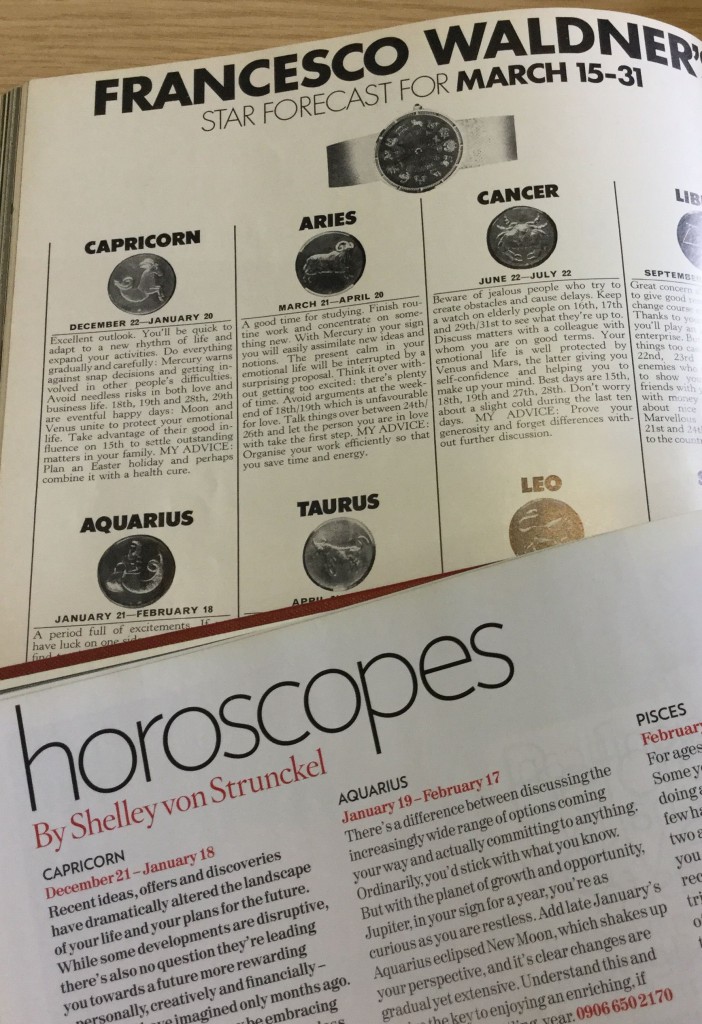
POPULAR CULTURE
VOGUE has always covered popular culture Over the years articles have included:
A piece on the young sculptor and artist Eduardo Paolozzi , who in the 1980s designed the glass mosaics at Tottenham Court Road tube station (November 1959).
A full page photograph of The Jam by Steven Johnson with brief caption describing them as being one of the new groups under the punk or New Wave banner (August 1977).
Ted Polhemus writing about punk and the filming of Jubilee, the Derek Jarman film (December 1977).
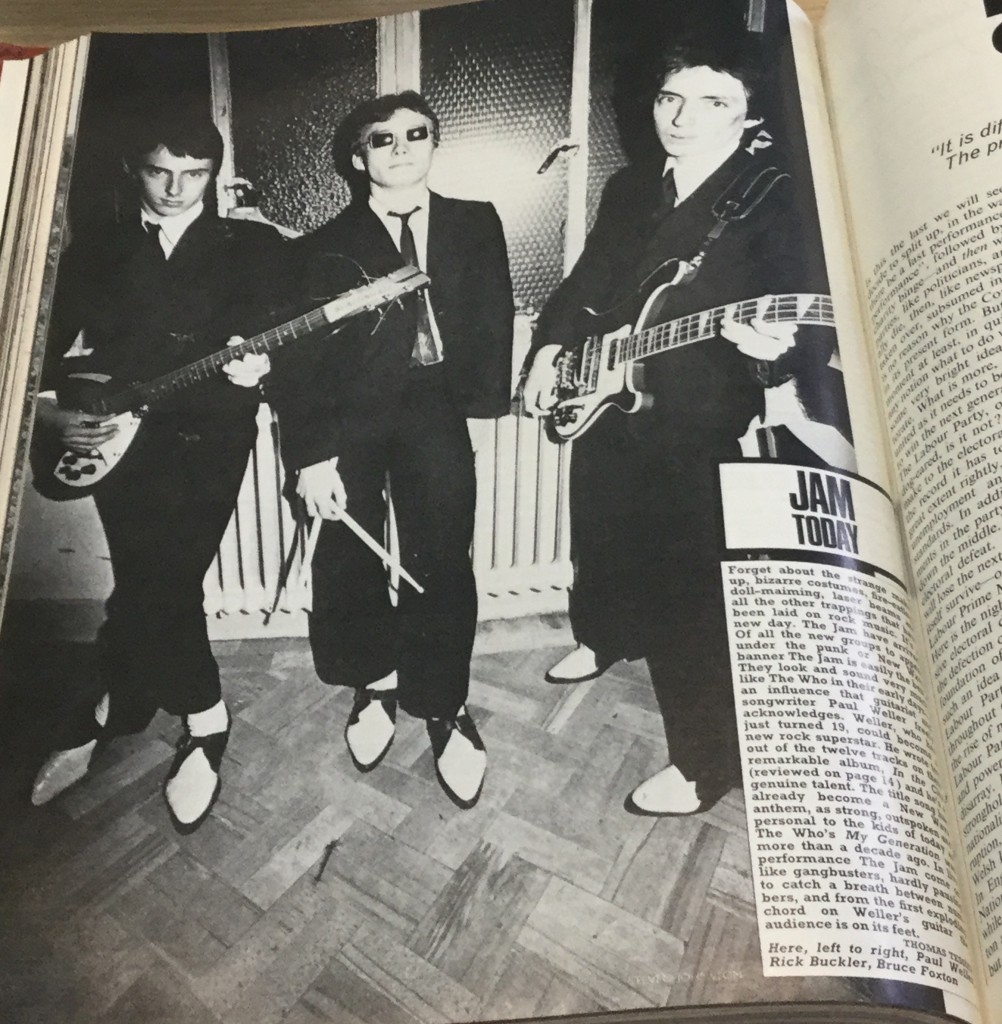
Today VOGUE has very limited coverage of the arts and popular culture with the View section having occasional interviews with artists, performers, film directors and actors.
The emphasis of the magazine has shifted completely towards fashion and beauty, with travel and culture taking a less important place in the magazine and the days when there were features on cooking and motoring within the pages of an issue have long since gone.
The Information and Reference Library takes the current issue of VOGUE every month and has a back file to May 1952.
Library members can access the entries in the Oxford Dictionary of National Biography and Who’s Who for the people listed above by clicking on the hyperlinks in the text.
See also VOGUE – Part 2: fashion on a budget.
[ Fiona Campbell, Library Assistant ]

